
REIMAGINING THE
REIMAGINING THE OCOEE WHITEWATER CENTER
Ocoee Whitewater Center Community Collaborative
Tom Barnett, General Manager, River Management, Tennessee Valley Authority
Doug Byerly, Staff Officer, Technical Services, US Forest Service, Cherokee National Forest
Lynne McClary, Executive Director, Polk County Chamber of Commerce
Derrick Sloan, Chairman, Industrial Economic Development Board, Polk County
Greer Tidwell, Deputy Commissioner, Bureau of Parks and Conservation, Tennessee Department of Environment and Conservation
Jenni Veal, Rural Destination Development Manager, Tennessee Department of Tourism Development
US Forest Service, Cherokee National Forest
Michael Wright, Forest Supervisor
Jesse English, Recreation Program Manager, Forest Landscape Architect
Christopher Joyner, Public Affairs
University of Georgia Carl Vinson Institute of Government
Leigh Askew Elkins, Principal Investigator, Senior Public Service Associate
Danny Bivins, Senior Public Service Associate
Kaitlin Messich, Senior Designer
T. Clark Stancil, Landscape and Urban Designer
Eleonora Machado, Creative Designer
Kelsey Broich, Creative Design Specialist
Garrison Taylor, Graduate Assistant
Brian Simmons, Public Service Assistant, Survey Research and Evaluation Support
Erik Thompson, Research Professional, Survey Research and Evaluation Support
Rhiannon Eades, Editor

Scan the qr code to access a digital version of this report
Special Thanks
To all of the participants who took time to share their stories, spent a few minutes on the survey, or pointed the project team in the direction of who else we needed to hear from – thank you. In particular, special thanks to Lynne McClary, Director of the Polk County Chamber of Commerce, for her tireless efforts in support of this public engagement process.
REIMAGINING THE OCOEE WHITEWATER CENTER PAGE 2
About the Project
The University of Georgia Carl Vinson Institute of Government and Studio Outside, along with S2O Design and Engineering, Dean Runyan and Associates, and Lake|Flato, collaborated with representatives from the US Forest Service - Cherokee National Forest to reimagine the Ocoee Whitewater Center. The first phase, led by the Institute of Government, engaged the public through focus groups, interviews, and an online survey. The critical feedback generated from this effort will inform the future of the Ocoee Whitewater Center site. Stakeholder and citizen input will help ensure that whatever redevelopment occurs reflects the wants and needs of the surrounding community and the many user groups that utilize the OWC site while respecting the natural beauty and historic importance of the Cherokee National Forest.

“We are working on history”
Michael Wright, Forest Supervisor, Cherokee National Forest
REIMAGINING THE OCOEE WHITEWATER CENTER PAGE 3

“I think everybody in Polk County had their picture taken there.”

REIMAGINING THE OCOEE WHITEWATER CENTER PAGE 4

Introduction
On April 26, 2022, the Ocoee Whitewater Center (OWC) visitor center was destroyed by fire. Nestled in the lush hills of Polk County, Tennessee, the Ocoee Whitewater Center was a tremendous point of pride for the surrounding communities and a celebrated asset for the tri-state Copper Basin region. A legacy of the 1996 Olympic Games, the building overlooked a twisting course built within the Ocoee River. The course, like the building, was specially designed for the whitewater canoe and kayak events. The
athletes, onlookers, and dignitaries during the storied summer of 1996.
In the years that followed the Olympics, the OWC quickly became a beloved community attraction and the center of outdoor recreation in the area, regularly attracting 300,000 annual visitors from across the region and beyond. Over the years, the OWC served myriad purposes. For a time, the building housed a restaurant and small gift shop, hosted community events, and served as a welcome center for visitors to the Cherokee National Forest. In 2020, Covid-19 closed the building to visitors. Many
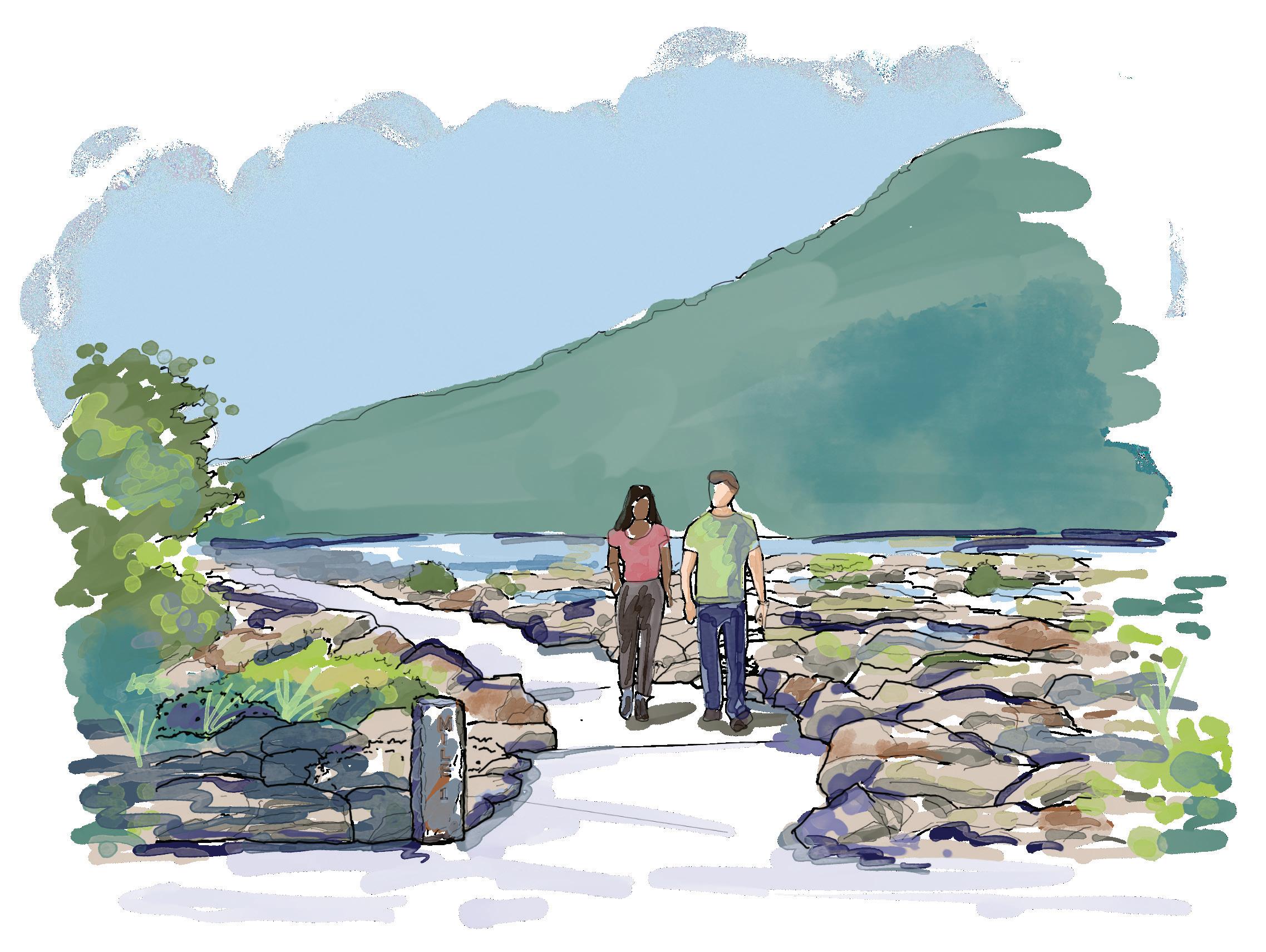
REIMAGINING THE OCOEE WHITEWATER CENTER PAGE 5

“It is so much more than the Olympics!”
REIMAGINING THE OCOEE WHITEWATER CENTER PAGE 6
community members felt that it never really reopened before the fire closed it for good.
While the water still flows and the adventure-minded still brave the rapids, the loss of the building leaves more than just a visible scar on the landscape. Visits to the site for picnicking, hiking, biking, or swimming in the Blue Hole just aren’t the same without the amenities once provided in the building itself. Travelers who happen by can only imagine the building that once anchored the site. Little is left to tell the story of the OWC and the site’s moment of international acclaim.
This tragic event created an opportunity to not just replace a building, but to consider the entire OWC property. The US Forest Service, in order to best plan for the future, launched a collaborative process to reimagine the OWC. The first step of this process was gathering thoughts, ideas, and memories

“There is such a rich history - the Cherokee Nation, the old Copper Road, even the TVA, there are so many stories to tell.”
from community members in Polk County and beyond to inspire and inform the site’s redevelopment. This report is a compilation of what community members shared in focus groups, interviews, and through an online survey. It is not intended to provide final recommendations for the site, but instead to relay what was most often heard during focus groups and interviews with local citizens about the site and the hopes for its future. One thing is very clear: careful long-term planning and intentional programming for the redevelopment of the entire Ocoee Whitewater Center site are not only necessary but deeply important to those who live in the area and to the tens of thousands of annual visitors drawn to this vital regional destination. The redeveloped site will be an outdoor destination, a community amenity, and an economic driver for this rural region.
REIMAGINING THE OCOEE WHITEWATER CENTER PAGE 7

From the Copper Basin Renaissance Strategic Vision and Plan
Scan the qr code to access the report
Surrounded by the rugged mountains and ridges of the Blue Ridge Mountains, the approximately 50-75 square mile geologic feature known as the Copper Basin spans communities across three states and boasts one of the South’s most unique histories. A rough and mighty river, Tennessee’s Ocoee and Georgia’s Toccoa, cuts and winds through the rolling hills and ridges of the Basin. Where Tennessee, Georgia, and North Carolina come together, communities have arisen over time, drawn to the mineral, hydrological, and agricultural resources of this area. In 1843, discovery of copper ore in Tater Creek changed the course of this area forever. From 1850 to 1987, copper and associated industries provided the lifeblood of communities throughout the Basin and beyond. At the height of mining in the basin, over 3,300 people were employed in mining and related industry. The over 90 million tons of copper ore extracted from Copper Basin mines including Burra Burra, Isabella, Boyd, and more, represented the Southeast’s largest metal mining operation. The over $35 million annual payroll of this oncethriving industry made the communities of Copperhill, McCaysville, and Ducktown a magnet for mountain farmers and others looking for decent wages and steady employment. During the height of industry in the Basin, in the 1940s and 50s, the downtowns of McCaysville and Copperhill offered residents and regional visitors an Appalachian-flavored slice of the American dream with bustling stores and restaurants, two movie theaters, car dealerships, and an array of creature comforts. These boom times came at a price. From the 1850s onward, deforestation and the release of sulfur dioxide from copper smelting left virtually the entire basin in a denuded state. Many remember being unable to dry clothes outside or acid rain eating away the paint on new cars practically overnight. Clearly visible on early satellite photos of the Southeast, the exposed red clay hills of the Copper Basin provided a test case for reforestation methods and the effects of soil erosion. Beginning in 1929 and accelerating in the late 20th century, reclamation and reforestation efforts have successfully brought plant and natural life back to what some geologists referred to as the “Ducktown Desert.” Largely forested now, many reminisce about the strange beauty of those red hills of days gone by.
REIMAGINING THE OCOEE WHITEWATER CENTER PAGE 8
public input process

In order to understand and plan for a place, it is important to hear from the people who live, work, and play in that place. The Institute of Government engaged hundreds of individuals through focus groups and individual interviews to help inform the future of the OWC. The diverse group of participants included students ranging from elementary to high school, rafting guides, long-time Polk County residents, educators, architects, small business owners, bartenders, restaurant managers, and others, including those who just enjoy the peace a river can bring.
Interviews and focus group discussions provided an opportunity for participants to share their fondest memories of the OWC,
what they would like to see (and not want to see) there in the future, and what did and did not work in its previous incarnation. The project team also asked public input participants for suggestions of others to talk to. These discussions provided rich information and important insights into the functionality of the building and the rest of the site, the desired improvements, and importance of this place to Polk County citizens and the whitewater community.
To reach a broader audience, the team developed and launched an online survey. They placed signage with a QR code in various locations on the OWC site and distributed postcards to businesses in and around Polk
REIMAGINING THE OCOEE WHITEWATER CENTER PAGE 9
County. The survey was accessible via the QR code and on the project website for approximately three months. During that time, more than 7,000 individuals from 38 states and three different countries provided responses. The survey responses, included in Appendix A of this report, provided additional important insights about the OWC. This input validated, in many ways, the discussions and conversations that occurred in focus groups and interviews.
To help guide the public input process, reach a broad audience, and to provide
perspective from a state-level view, the Ocoee Whitewater Center Community Collaborative formed. This group brought together representatives from the Tennessee Valley Authority, the Tennessee Department of Environment and Conservation, Tennessee Department of Tourist Development, Polk County Chamber of Commerce, Polk County Industrial Development Authority, and the US Forest Service in support of the redevelopment of the OWC site.
Representatives from these agencies and organizations provided valuable insight,
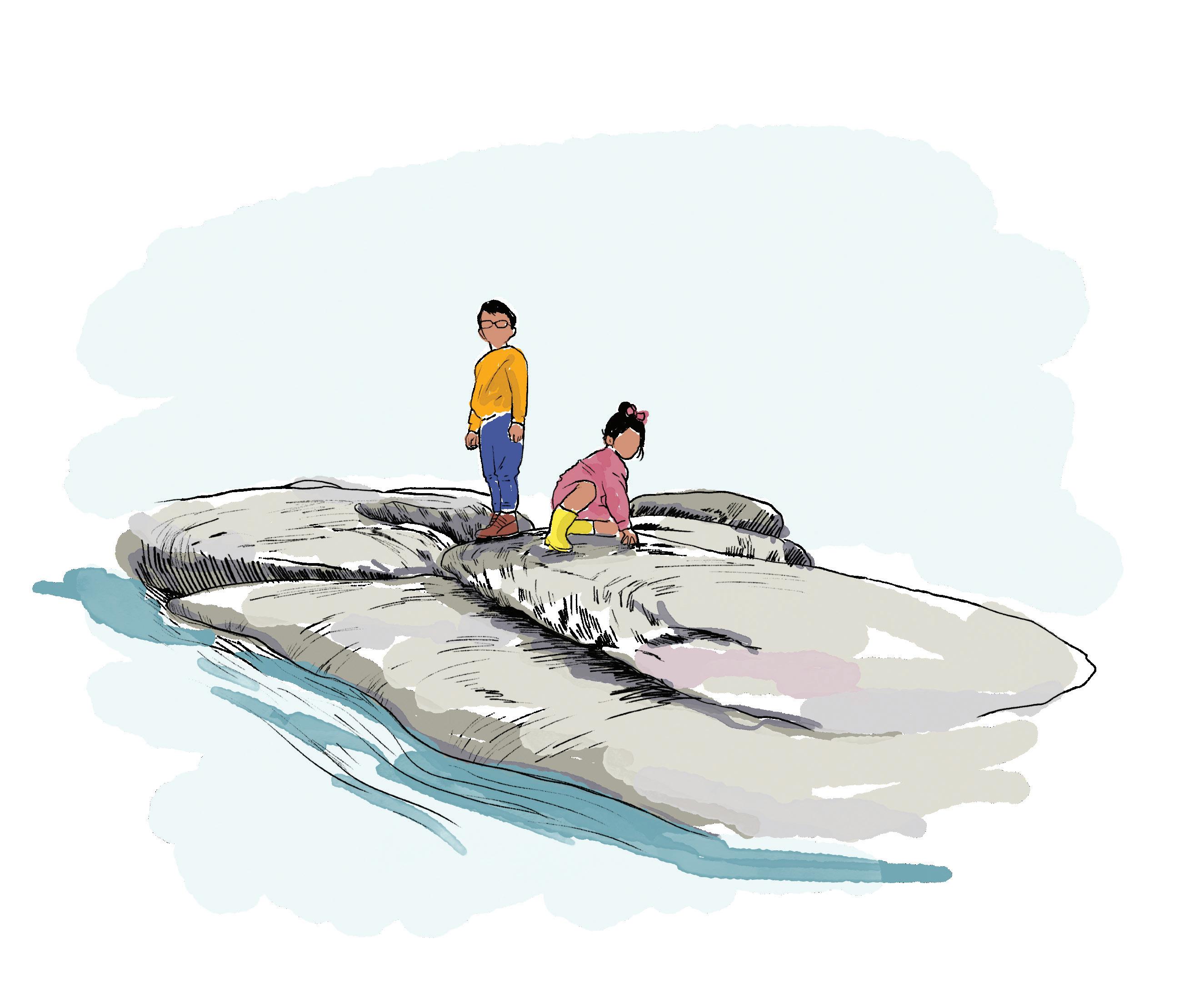
REIMAGINING THE OCOEE WHITEWATER CENTER PAGE 10
“I grew up swimming in the Blue Hole, walking in the woods. It’s just an unbelievable place.”
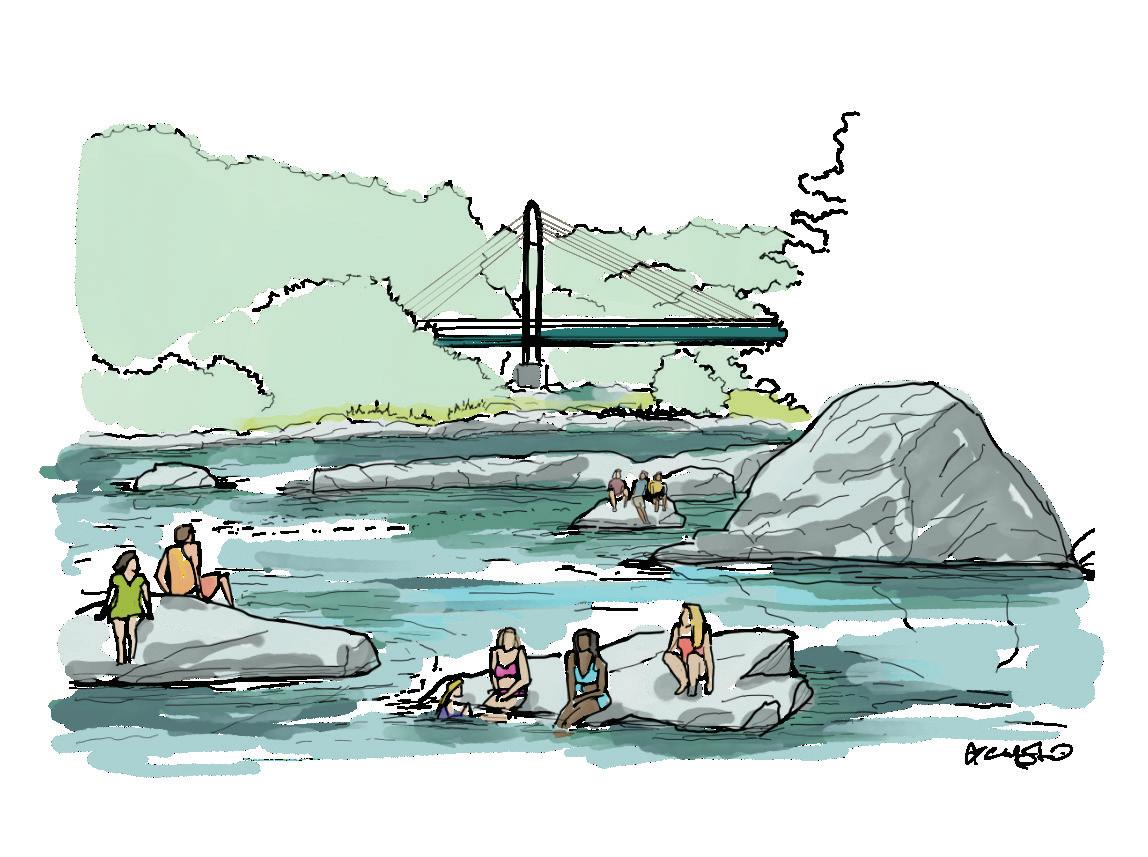
strong connections to state leadership, and their own connections to the OWC, its history, and their hopes for its future.
While the engagement process reached a diverse group of participants, the project team was unable to connect with mem-
bers of the Eastern Band of the Cherokee Nation. The project team attempted several avenues to make a connection but were unsuccessful. As the project moves towards design, efforts to engage this important constituency are vital.
REIMAGINING THE OCOEE WHITEWATER CENTER PAGE 11
WHY MIGHT YOU VISIT THE OWC?

61% 69% 62% 85% to enjoy the scenery to be with friends and family to be close to nature to participate in recreational activities
What recreational activities, if offered by the OWC, would you participate in?

67% 78% 75% 81% hiking nature viewing picnicking swimming/ waterplay
REIMAGINING THE OCOEE WHITEWATER CENTER PAGE 12

What information would enhance your experience?
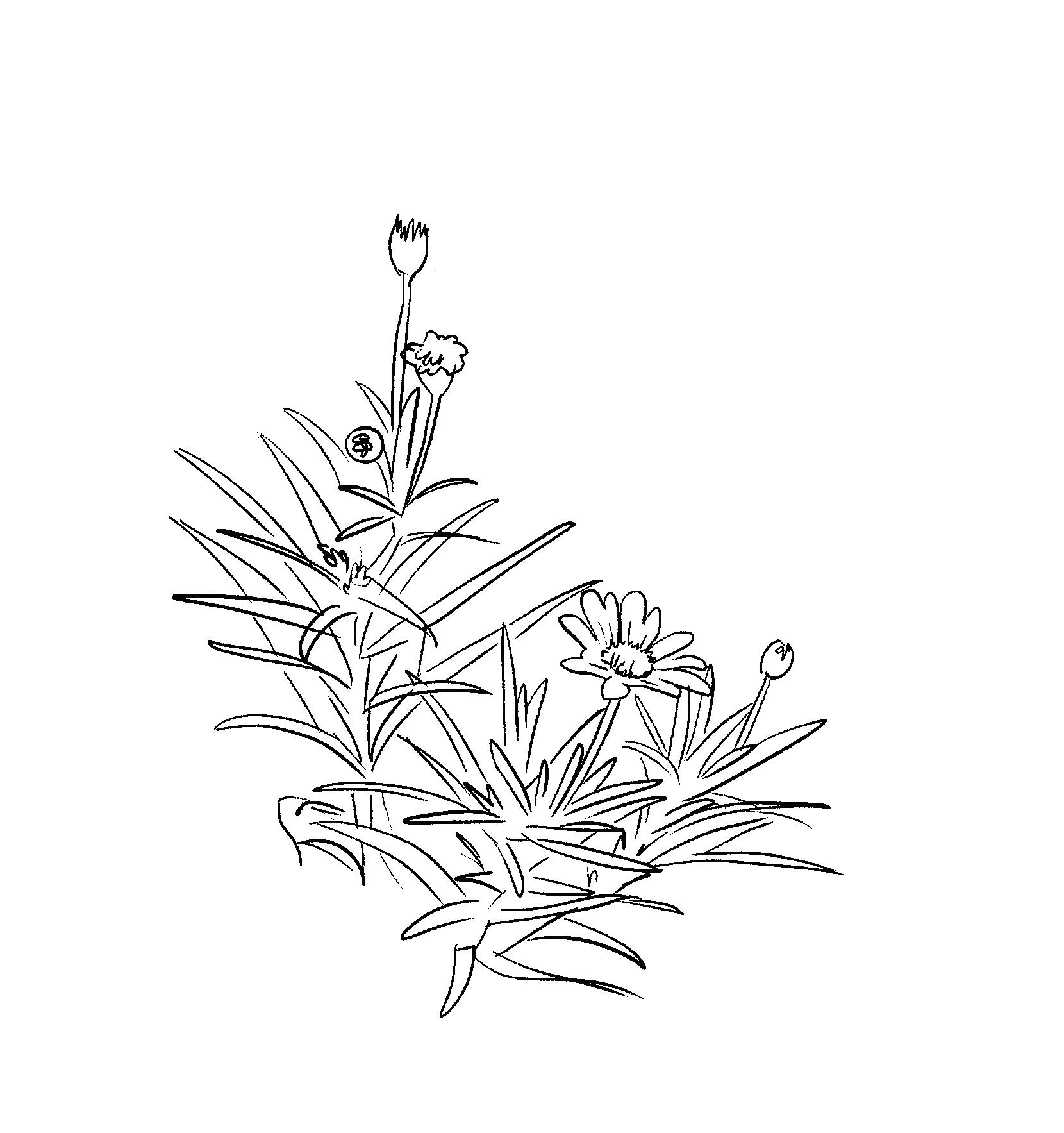

57%
53%
Wildlife in the Cherokee National Forest and Ocoee River
52%
Flora and Fauna of the region
History of indigenous people of the region
50%
History of the OWC and the 1996 Olympics
REIMAGINING THE OCOEE WHITEWATER CENTER PAGE 13


Food options that would enhance the experience: Event
spaces: 47% 28% Concession stand Food trucks 31% 81% 55% small indoor space covered outdoor space large indoor space REIMAGINING THE OCOEE WHITEWATER CENTER PAGE 14
Lack of food options
Obstacles or issues prior to the fire: 19% 32% 36% 50%
Seasonal closure

Hours of operation


Lack of overnight lodging
REIMAGINING THE OCOEE WHITEWATER CENTER PAGE 15
What the Project Team Heard
Throughout the public engagement process, there was a clear concern from many in the Polk County community that the OWC would never be rebuilt.

Residents often expressed a fear that the rubble would be cleared, but nothing would be constructed in its place. There was a sense from many that the building itself was really lost when the Covid-19 pandemic forced the closure of the facility. Many community members reported feeling like the OWC never fully reopened. There was also a sense among may local residents that the US Forest Service has little interest in investing to replace the building and improve operations.
Though residents expressed some underlying frustrations, the project team also heard over and over again what a special place this is. Participants praised the natural beauty of the site and the way the building really fit into the landscape. The project team heard about and experienced the tranquility of the place. Many public input participants shared how much they love the surrounding natural environment, the Blue Hole, and how much they missed those rocking chairs on the porch of the OWC. As peaceful as this place can be, it is also an incredibly active place with hiking, biking, whitewater rafting, kayaking, and canoeing. It is a gathering space–for those passing through, for friends and family, for the world–but the
Polk County community feels ownership for the place.
When asked, nearly every public input participant could remember where they were when they heard that the OWC had burned down. While the fire remains a painful memory to many, this process has given hope that this tremendous loss for the community can and will be a catalyst to improve the entire site and provide new amenities, opportunities, and experiences for visitors to the OWC.
The engagement process and its resulting comments and conversations provide clear direction that supports four categories of consideration for the US Forest Service to address as the redevelopment of the OWC moves forward. The details that follow are organized by these four areas: amenities, programmatic elements, physical experience, and operational recommendations. While these areas of consideration represent the comments gathered through the public input process, they are not the final determination as to what will be redeveloped at the OWC. These locally-identified issues serve to provide community feedback to the US Forest Service and offer insight on what residents wish to see on the OWC site.
REIMAGINING THE OCOEE WHITEWATER CENTER PAGE 16




areas of consideration amenities
REIMAGINING THE OCOEE WHITEWATER CENTER PAGE 17
Physical Experience Programmatic Elements Operational Recommendations
amenities

When local residents reflected on amenities available at the Ocoee Whitewater Center, they primarily focused on what the site’s new building would include. Participants felt that the building itself should blend into the landscape, rely on natural materials for construction, and not feel intrusive on the site. Any built structures on the site should also be accessible for all ages and abilities. A commitment to accessibility should extend to any information, exhibits, and new features on the site.
Because the site itself is focused on water, accessibility should extend to the river’s edge. Even during high flow days, safe opportunities for interacting with water for all ages and abilities should be a priority. Whether through a water playscape that models the Ocoee or some other interactive design, the redeveloped site should provide water play outside of the river channel.
Restrooms should be clean, safe, accessible, and available year-round. In addition to restrooms in the new building, improvements should be made to the pit toilets and port-o-johns that currently exist on the site. Restrooms could also provide changing space and potentially showers.
Whether food trucks or a casual restaurant, public input participants requested some kind of food and beverage service on site. Half of the survey respondents viewed the lack of dining opportunities as an obstacle or issue prior to the fire, and nearly every focus group discussed the need to have some kind of food service on site. Residents often noted that on-site dining should be more than grab-and-go items that might be found in a retail operation, though items like granola bars could be welcome additions for through-hikers and similar users.
Many residents viewed meeting or event space as a valuable addition to the OWC site. The original building did have a small meeting space available for community use. Some public input participants discussed that a larger space could accommodate beneficial community programming, such as swift water rescue training or a meeting of the Polk County Chamber of Commerce. Many


REIMAGINING THE OCOEE WHITEWATER CENTER PAGE 18
residents also voiced significant support for a covered outdoor space or spaces that could be used for weddings, family reunions, or school events like the prom.
A new multifunctional building could also serve as a regional welcome center with full-time staff. Public input participants noted that the facility should provide information on the region, connect visitors to the community, and serve as a front door to the Cherokee National Forest. There should be regular business hours that extend yearround. It is important for the site to support
the local economy by pointing visitors to businesses within the community.
Local residents often requested some type of gift shop or retail space in the building. Several participants recommended a space that features and sells the works of local artisans. Others suggested a retail space for trinkets or souvenirs. There was also some support for retail that focused on outdoor activities, specifically biking, hiking, camping, and kayaking. There was little to no support for large commercial retail operations.
programmatic elements
There are so many stories to tell about the history of the Copper Basin, and the OWC is an ideal place to share those stories. The OWC also provides a unique opportunity to create connections to other places and destinations in and around Polk County. Linking the OWC site to surrounding outdoor recreation outlets and tourist destinations could provide a vital boost to future economic development in the region. Because approximately 80% of Polk County lies within the Cherokee National Forest and nearly 50% of the county is actually owned by the United States of America, developing economic opportunities around the OWC could have a positive financial impact on the county.
Programmatic elements that draw visitors to the OWC are important considerations for the future of the site.
From the history of the Cherokee and the Old Copper Road to the legacy of the Tennessee Valley Authority and the 1996 Olympic Games, the OWC offers a prime venue to tell the stories of the Cherokee National Forest. Whether through rotating or permanent displays with some interactive or engaging elements, the OWC can enhance visitor offerings and build on the educational experiences that were once part of its operations.

Many focus group participants fondly recalled school field trips to learn from Smokey Bear or to see the creatures living in the river. Others recalled the native plant garden or fishing days held on site.
REIMAGINING THE OCOEE WHITEWATER CENTER PAGE 19
A new pavilion could serve as an outdoor classroom and would provide incredible opportunities for school field trips or evening lectures to engage all ages in the area’s natural environment and rich history. Opportunities to highlight native plants--like Ruth’s Golden Aster, found nowhere else in the world--through presentations, exhibits, and gardens could connect the community and others to the Cherokee National Forest’s flora and fauna.
Although some residents still suffer “five ring fatigue,” the story of the Olympics is a vital element of the OWC’s legacy. The 1996 Summer Olympics are the reason the site was constructed in the first place. Sadly, many mementos from the ’96 Olympics were lost in the fire. However, there are opportunities to receive donations from those who have kept their own important pieces of this Olympic history that could be displayed in a new building. One focus group participant even has a kayak that raced

In addition to programmatic considerations inside the building, there are opportunities to revive outdoor programs as well. The Ocoee River Championships were held in 2018 and 2019. The event was hugely popular and was scheduled to continue in 2020, but it was cancelled because of the Covid-19 pandemic. Reviving this event could not only showcase talented athletes but also bring tourism dollars to surrounding communities. Some focus group participants spoke of concerts held at the site and want to revive those musical performances. Others mentioned ideas like car shows or market days where vendors could set up and sell their goods. Their important point was the need to activate the space. Whether an event is in the river or alongside of it, regular, intentional active use would benefit the county in positive ways. Mountain biking and trail running events, as well as creative events like festivals could bring visitors to the area to support the regional economy. The site should be a catalyst for increasing the average visitor’s time spent in Polk County.


Cherokee National Forest – US owned Cherokee National Forest – Various Owners REIMAGINING THE OCOEE WHITEWATER CENTER PAGE 20

Physical experience
The physical experience focuses on outdoor amenities needed to improve or enhance a visit to the OWC. From more picnic tables and trash cans to water bottle filling stations, public input participants clearly expressed their needs.
While picnic tables might not be the most exciting thing to add to the site, they can significantly enhance a visitor’s experience
might be looking for a snack. Because picnicking is a popular activity at the OWC, it makes sense that additional tables and trash cans are top priorities.
Water bottle filling stations or water fountains are also desired additions. Whether someone is hiking, biking, or picnicking, having easy access to potable water is important. Water stations should also be in locations outside of the building, accessible

REIMAGINING THE OCOEE WHITEWATER CENTER PAGE 21
building. As one participant said, “There is just something about rocking on a porch watching the water roll by that is soothing to the soul.”
Signage is another significant need, not just onsite but along US Highway 64 as well. Because the lower entrance is awkwardly designed and poorly marked, it is quite easy to miss. In addition, the upper entrance is also very easy to miss and needs signage in both directions noting when to turn. The corridor would benefit from additional signage noting distance to the OWC and to other riverside parking as well.
Changes to the river corridor through the site to add put-ins and pull-outs, as well as areas to easily park multiple rafts for a break, would be welcomed improvements. Changes to the warning system alerting visitors to high flows should also better indicate the timing of the higher flows. At the very least, signage on site indicating the
timing of flows once the horn sounds would provide visitors with a clearer understanding of what to expect and when.
There are other elements that while not overwhelmingly requested should be considered as the site is redesigned and updated. Features like phone charging stations, bike racks, and lockers for personal belongings can provide outdoor adventurers with a home base. Participants also mentioned an ATM, if parking fees remain cash only, and a vehicle charging station. One other key need, from primarily a safety perspective, is Wi-Fi access and cell phone service. People have become incredibly dependent on their phones–to contact others, for directions, and when necessary, to seek emergency assistance. Given the nature of activity that takes place in and around the OWC, location awareness and quick access to help if needed are of critical importance.



REIMAGINING THE OCOEE WHITEWATER CENTER PAGE 22

Operational Recommendations
Public input participants expressed strong feelings regarding the OWC’s overall operation. Many in the community felt that the US Forest Service was not committed to the facility as it was, because the building had variable operating hours and was not open year-round. The fear that the OWC would not be rebuilt was pervasive among local residents. Frustration with the length of time it took to get permits for events or activities to be held on the site; frustration with guides no longer allowed to stop their boats and provide lunch on the site; and frustration with the lack of food for purchase by visitors were echoed in multiple focus groups and revealed in the survey as well.
Because of the perceived operational frustrations and feelings that the US Forest Service is not connected with the larger Polk County community, a number of participants recommended that Tennessee State Parks take over all operations of the OWC site through a long-term land lease agreement. Tennessee State Parks has an outstanding reputation in the region and is already operating in the area at the Hiwassee/Ocoee Scenic River State Park.
Community members see this as an opportunity to improve relations between the US Forest Service and the communi-
ty while enhancing the operations of the OWC. One of the most important operational considerations expressed was the need for consistent, year-round operational hours. Clear operating hours must be established and maintained. Additionally, because of frustrations with the permitting process to have an event on the site, participants felt that if the state operated the site, permit processes would be less burdensome.
Rafters, kayakers, and whitewater canoeists, whether professional outfitters or individual enthusiasts, would certainly like to see more high flow days in the river. The Tennessee Valley Authority controls the flows, and increasing the number of days that create Class III and IV rapids would benefit the area economically and enhance other adventure tourism opportunities. Calendaring additional high flow days would have an immediate positive impact.
Many of the activities in and around the OWC site have inherent dangers associated with them. Whether someone has a twisted ankle on a hiking trail, a fall off a mountain bike, or a spill from a raft onto a rock, fast access to the right medical equipment and medical care is essential. Providing space in a new building to store medical and rescue equipment should be a priority, and any reconfiguration of the site should maintain the helicopter landing pad in the parking lot.
REIMAGINING THE OCOEE WHITEWATER CENTER PAGE 23
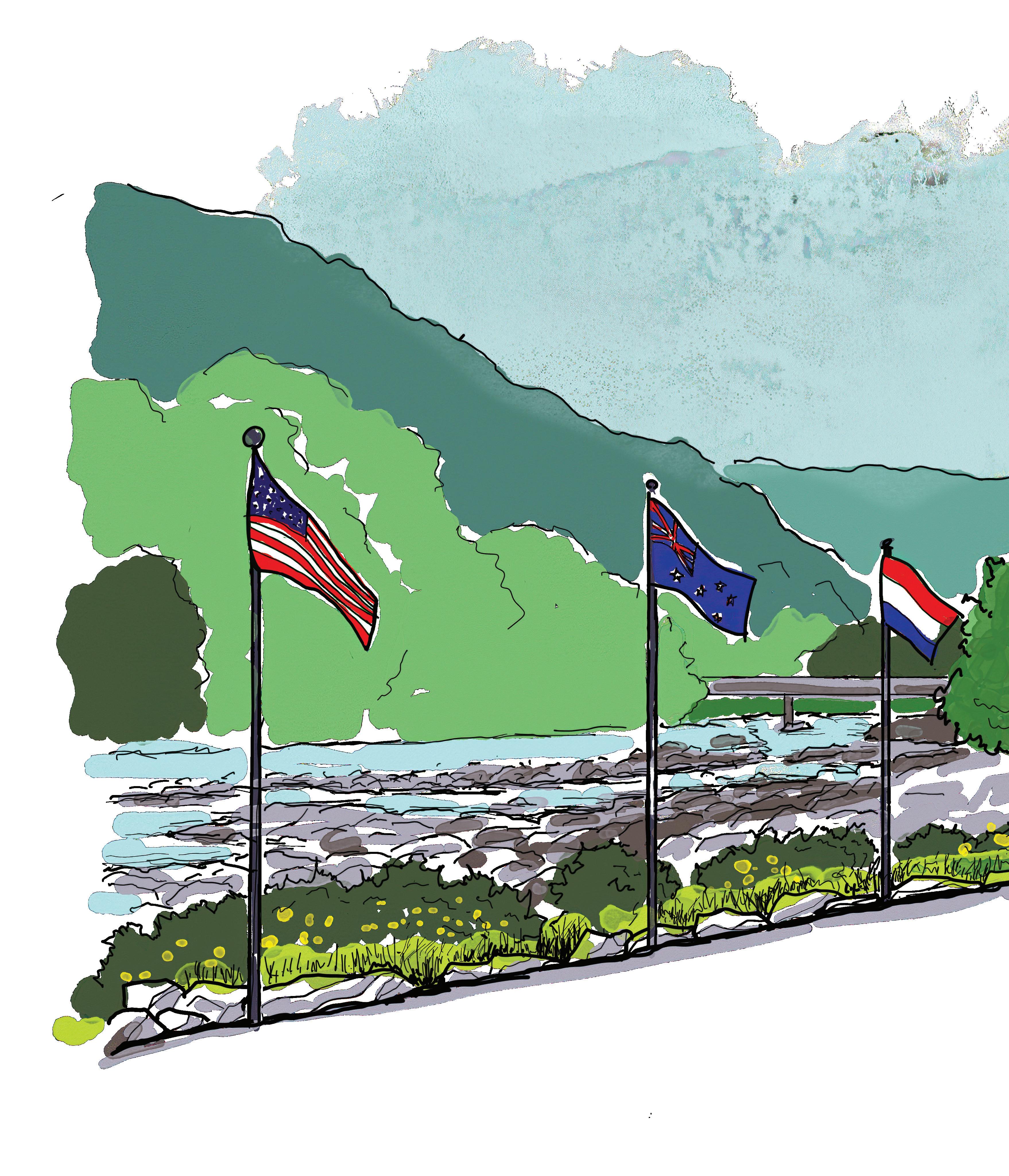
“The whole world came to Polk County. Who would have ever thought that would happen?”
REIMAGINING THE OCOEE WHITEWATER CENTER PAGE 24

conclusions

The loss of the Ocoee Whitewater Center was tragic for the Polk County community. Out of the ashes, this painful loss offers the Copper Basin the potential for more than just a new building. The chance to improve the overall operations, amenities, and programming at this regionally-significant destination creates a tremendous opportunity for Polk County and the surrounding area. The US Forest Service is right to carefully plan for the future of the OWC. Engaging the public through a survey, focus groups, and interviews has provided recommendations that may not have been on the table before. The Forest Service should give careful consideration to how this site can successfully serve the surrounding community, the whitewater community, and other entities now and into the future. The OWC has lots of stories to tell and many adventures to share. It is up to the US Forest Service to write the next chapter.
REIMAGINING THE OCOEE WHITEWATER CENTER PAGE 25
Scan the QR Code to access a digital version of this report
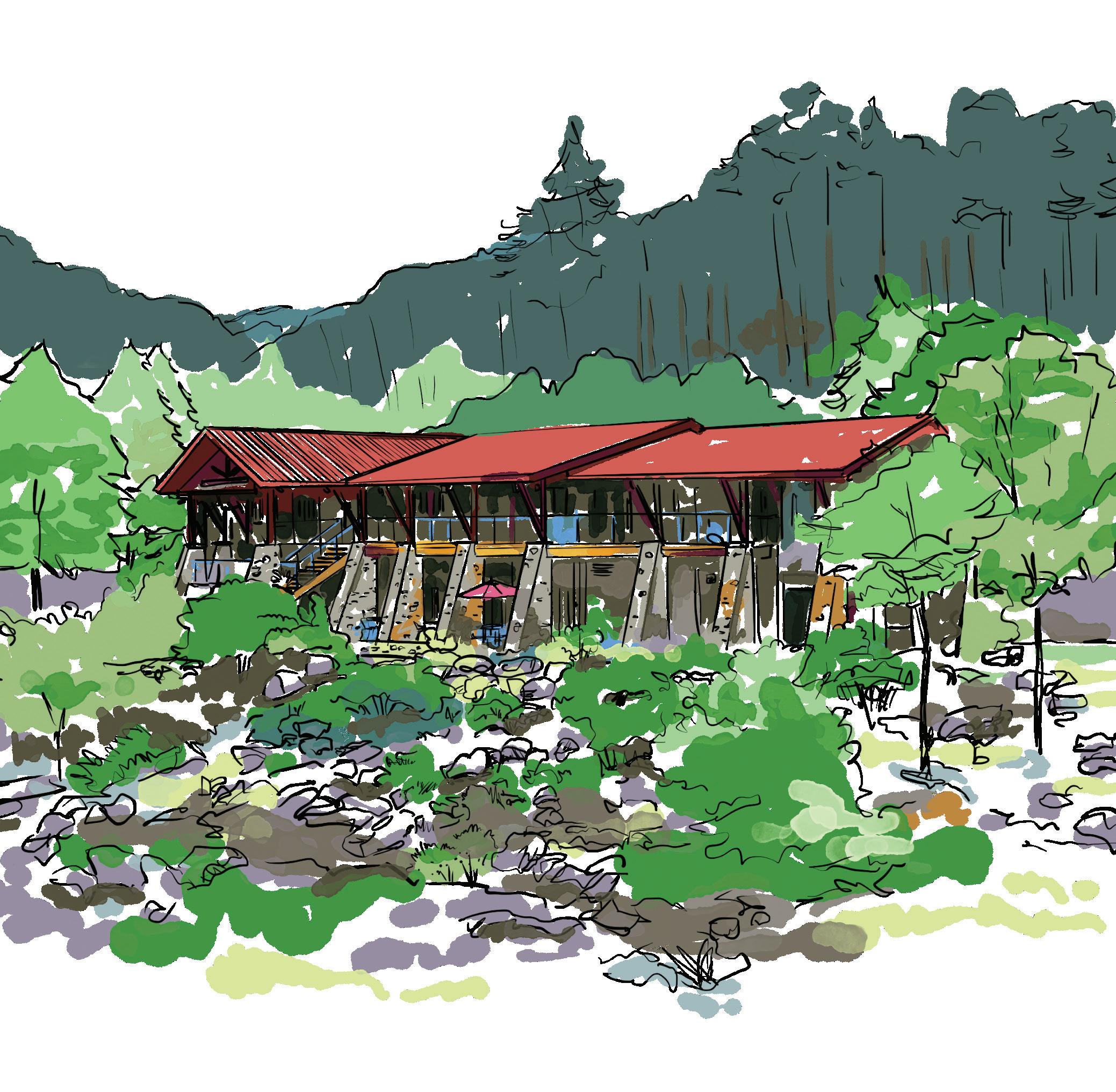
appendix a
REIMAGINING THE survey results
survey results

On April 26, 2022, the Ocoee Whitewater Center was destroyed by fire. A legacy of the 1996 Olympic Games, the OWC was a tremendous point of pride for the surrounding communities and a celebrated asset for the region. The loss leaves a significant void in the community. However, from this tragic event comes the opportunity to look at the entire site, and this survey provided an opportunity for approximately 7,000 people to share their thoughts on the future of the OWC. The results included here, along with input from interviews and focus groups, will help reimagine the OWC and inform the future of this remarkable site.
APPENDIX A: SURVEY RESULTS | REIMAGINING THE OCOEE WHITEWATER CENTER PAGE 28

Prior to the 2022 fire, have you ever visited the Ocoee Whitewater Center?
I don't know
On average, how often have you visited the Ocoee Whitewater Center in the past five years?
I have not visited the Ocoee Whitewater Center in the past five years 5%
Yes 89% No 10%
1%
14% 17% 42% Once a month 5% Several times a month 11% Once a week 2% Several times a week 4% Less than once a year Once a year Several times a year APPENDIX A: SURVEY RESULTS | REIMAGINING THE OCOEE WHITEWATER CENTER PAGE 29
How likely are you to visit the Ocoee Whitewater Center following the renovation?
For those who responded that they were not at all likely to visit a renovated OWC, they were asked the following: What are the reasons you would not like to visit the Ocoee Whitewater Center following renovations?
Not at all likely 1% Somewhat likely 9% 30% 58% I'm not sure 2% Very likely Extremely likely
Not interested in a Whitewater Center Area is too crowded 9% Previous management issues 9% Commute is too long 13% Want center to be restored to its natural state 13% Prefer funds to be allocated diffferently 20% 50% APPENDIX A: SURVEY RESULTS | REIMAGINING THE OCOEE WHITEWATER CENTER PAGE 30
During which season(s) would you most likely visit the Ocoee Whitewater Center? (Select all that apply)
Which of the following best describes why you might visit the Ocoee Whitewater Center?
70% 84% 82% 29% Spring Summer Fall/Autumn Winter
all
85% 69% 62% 61% 50%
learn about the history of the
To enjoy the scenery To be close to nature To be with friends/family To participate in recreational activities To see wildlife 40% To be with people who have similar interests to mine 32% To learn about the environment 28% Competitive events 23% Other 9% I have no interest in visiting the Ocoee Whitewater Center 0% APPENDIX A: SURVEY RESULTS | REIMAGINING THE OCOEE WHITEWATER CENTER PAGE 31
(Select
that apply)
To
region
Please indicate your likelihood of participating in the following recreational activities if offered by the Ocoee Whitewater Center:

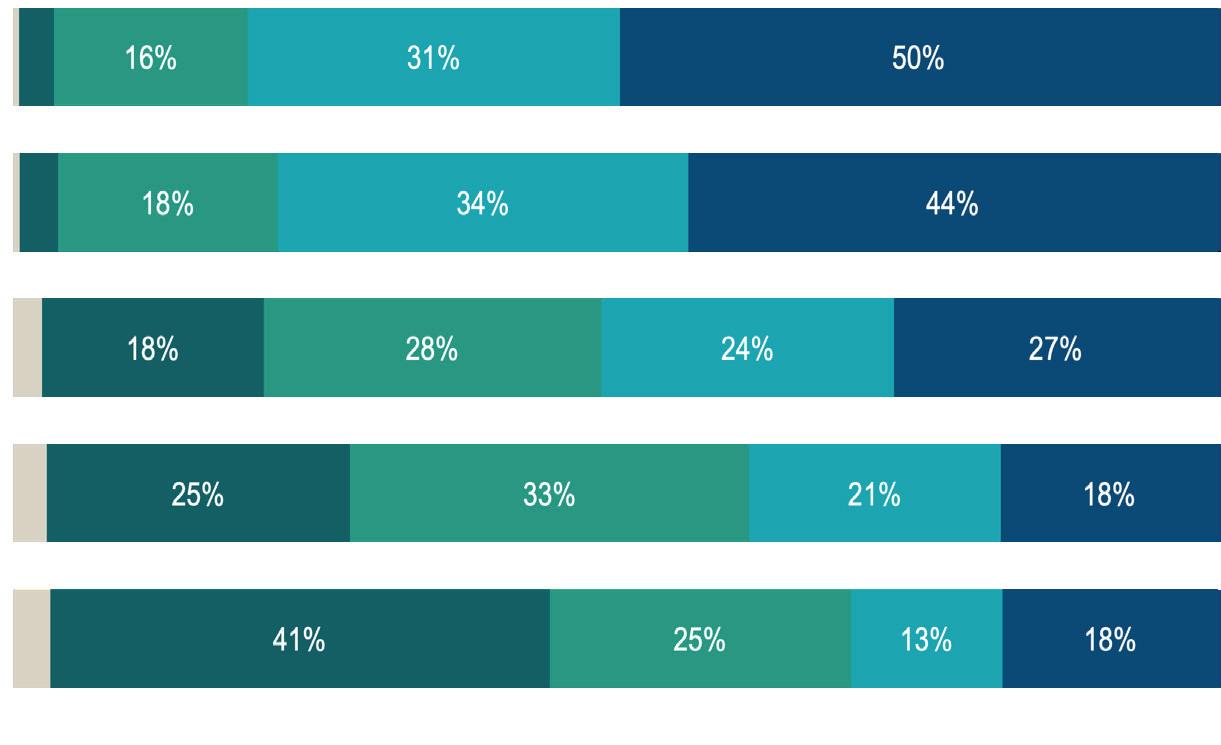
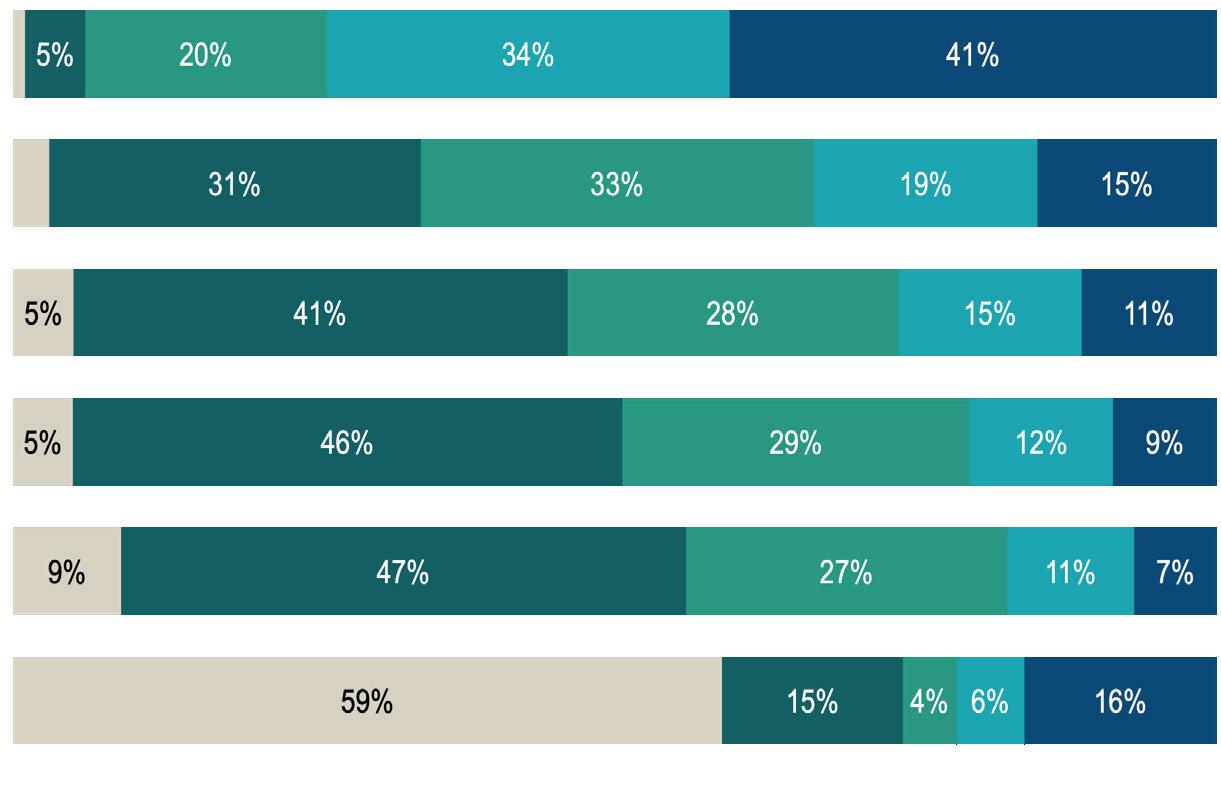

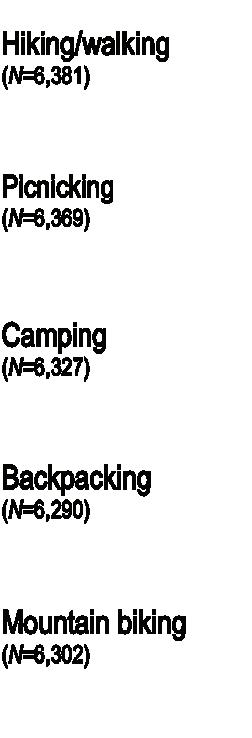

APPENDIX A: SURVEY RESULTS | REIMAGINING THE OCOEE WHITEWATER CENTER PAGE 32
Who would you primarily participate in recreational activities with?
Which of the following amenities would enhance your experience the most while visiting the Ocoee Whitewater Center? (Select your top four)
66% 27% No one (i.e., do activities alone) 4% A group (2 or more other people) One other person A guide or instructor 3%
Picnic tables Water fountain/water bottle filling station Trash cans Additional furniture for sitting Wi-Fi access Showers 73% 71% 56% 46% 39% 23% Phone charging stations 12% Bike racks 12% Lockers for personal belongings 11% ATM 4% Vehicle charging stations 3% Other 12% None of the above 1% APPENDIX A: SURVEY RESULTS | REIMAGINING THE OCOEE WHITEWATER CENTER PAGE 33
What information would enhance your experience the most while visiting the Ocoee Whitewater Center? (Select your top three):
Which of the following food options would enhance your experience the most while visiting the Ocoee Whitewater Center?
Information about the types of wildlife of the Cherokee National Forest and Ocoee River A history of indigenous people in the region A history of the Ocoee Whitewater Center 57% 53% 52% 50% 36% 26% Other 3% None of the above 2% Information about the types of plants and natural resources of the Cherokee National Forest and Ocoee River A history of the Ocoee Whitewater Center's role in the 1996 Summer Olympic Games Information about habitat rehabilitation efforts around the Ocoee Whitewater Center 47% 28% 12% Other 6% None of the above 6% Food trucks Concession stands Vending machines APPENDIX A: SURVEY RESULTS | REIMAGINING THE OCOEE WHITEWATER CENTER PAGE 34
Which of the following spaces would enhance your experience the most while visiting the Ocoee Whitewater Center?
Please indicate the type of event space you would use if available to rent by the Ocoee Whitewater Center. (Select all that apply)
40% 27% 21% None of the above 8% Other 4% Campgrounds Event space rentals Stage/amphitheater 55% 31% 81% Uncovered outdoor event space 16% Small indoor event space Large indoor event space Covered outdoor event space APPENDIX A: SURVEY RESULTS | REIMAGINING THE OCOEE WHITEWATER CENTER PAGE 35
Please indicate your level of interest in the following retail options if offered by the Ocoee Whitewater Center:
Please indicate how likely you are to utilize the following transportation and trail options to travel to and from the Ocoee Whitewater Center:
12% 16% 19% 38% 39% 39% 26% 27% 25% 22% 16% 14% Not at all interested Somewhat interested Very interested Extremely interested I'm not sure Gift shop (N=6,040) Gear and equipment rental (N=5,955) Gear and equipment purchase (N=5,923) 5% 15% 53% 28% 24% 26% 11% 27% 7% Bus shuttles to and from local communities (N=5,963) A multi-use, pedestrian trail between Copperhill and McCaysville (N=5,966) Not at all likely Somewhat likely Very likely Extremely likely I'm not sure APPENDIX A: SURVEY RESULTS | REIMAGINING THE OCOEE WHITEWATER CENTER PAGE 36
Prior to the 2022 fire, what obstacles or issues, if any, did you face when visiting the Ocoee Whitewater Center? (Select all that apply)
Do you live in the United States?
50% 36% 32% 19% Lack of information about the center 11% Unclean facilities 10% Lack of trash cans 10% Expensive user fees 7% Safety/security 6% Handicap inaccessible 4% Lack of transportation to and from the Ocoee Whitewater Center 4% Other 7% I did not face any obstacles when visiting the Ocoee Whitewater Center 22% Lack of food options (e.g., vending machines, concession stands, etc.) Seasonal closures Hours of operation Lack of overnight lodging
Yes 99.9% No 0.1% APPENDIX A: SURVEY RESULTS | REIMAGINING THE OCOEE WHITEWATER CENTER PAGE 37
1% 13% 20% 21% 20% 17% 7% 1% 0% 0.03% 10-19 20-29 30-39 40-49 50-59 60-69 70-79 80-89 90-99 100-109
What is your age?
Female 58% Male 41%
1% APPENDIX A: SURVEY RESULTS | REIMAGINING THE OCOEE WHITEWATER CENTER PAGE 38
What is your gender?
I prefer to selfdescribe
Are you of Hispanic, Latino, or Spanish origin?
What is your race? (Select all that apply)
I prefer to self-describe (please specify): 3%
American Indian or Alaskan Native 3% Asian 1%
Black or African American
Native Hawaiian or Pacific Islander
No 98% Yes 2%
White 93%
0.3%
0.2% APPENDIX A: SURVEY RESULTS | REIMAGINING THE OCOEE WHITEWATER CENTER PAGE 39
What is your average household income?
How many children (i.e., under 18 years of age) live in your household?
37% 19% 20% 12% $20,000 to $34,999 8% Less than $20,000 4% Over $100,000 $75,000 to $99,999 $50,000 to $74,999 $35,000 to $49,999 61% 16% 15% 6% 2% 1% 0.1% 0.1% 0.0% 0.0% 0.0% 0.0% 0.1% 1 2 3 4 5 6 7 8 9 10 11 12 13
APPENDIX A: SURVEY RESULTS | REIMAGINING THE OCOEE WHITEWATER CENTER PAGE 40

“Angels
came down and dropped a little piece of heaven at the whitewater center”

















































